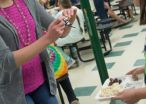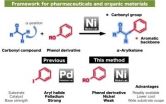(Press-News.org) In terms of ambience, Charlotte Central's cafeteria is -- well, conjure up your own elementary school lunch experience. There's more than one reason to run to recess. But on a recent visit to observe a group of researchers from UVM's Johnson Lab, the lunch ladies were serving up something more likely to be found on a restaurant menu: risotto with mushrooms and peas. It's the result of a host of programs by schools around Vermont to offer more tempting choices -- with locally sourced ingredients when possible, including herbs and vegetables from the playground garden -- and to get children to eat more healthfully. But is it working?
That's what Rachel Johnson, Robert L. Bickford Jr. Green and Gold Professor of Nutrition and Food Sciences, along with her research team, is trying to find out. And they aren't alone in their concern. Since Fall 2012, USDA regulations require students across the country to take a fruit or vegetable with their lunch, a good intention that might easily go to the garbage.
To get answers about what actually happens to those dressed up peas and mushrooms -- or the obligatory apple next to the mac and cheese -- the Johnson Lab has developed state-of-the-art digital imaging to measure consumption, a method just validated by a paper published in the Journal of the Academy of Nutrition and Dietetics.
The researchers, Johnson's "army of undergraduates," image children's trays when they leave the line and then again when they're finished eating. They've already weighed and photographed a correct portion of each fruit and vegetable item offered, as well as analyzed recipes to determine how much fruit and vegetable a serving contains.
Back at the lab, visually comparing the composite before and after photos alongside the comparison data, researchers can accurately determine consumption within two grams, a statistically valid but much less labor-intensive means of assessing dietary intake compared to the current gold standard of individually weighing portions selected before a child can eat against plate waste. The time saved allows for a much larger sample size.
"Now we're exploring ways to employ the method," says Johnson's doctoral student Sarah Amin. In Charlotte she's leading a new study to evaluate whether non-researchers -- parents, teachers, community volunteers -- can be trained to collect the data with equally valid results. The process involves taking the tray image at an accurate angle for later analysis, while also capturing the number on lanyards that participating children wear to track the trays.
If the research is successful, explains Amin, it has broad implications for collecting data on a larger scale, including Web-based training that could be done anywhere. "There are amazing interventions to get kids to eat more fruits and vegetables -- farm-to-school programs, school gardens -- and we know that exposure to foods helps develop preference for those foods -- so we're interested in accurately measuring what they're eating," says Johnson. "I would love for our lab to become the go-to place in the country to help evaluate the efficacy of these interventions."
Not too cool
In another study from the Johnson Lab, led by Amin and published this spring in the Journal of Child Nutrition and Management, researchers found that the fruits and vegetables that students are choosing at lunch are largely processed versions, primarily 100 percent fruit juice and high calorie entrees such as pizza and lasagna, with the tomato in the sauce qualifying as a vegetable.
But Johnson is optimistic that over time, with the introduction of appealing whole fruits and vegetables into familiar favorites, for instance, that kids will come around. Research associate Bethany Yon, in a study recently published in the Journal of School Health, in fact, has shown that it's worked with flavored milk. When the dairy industry, in advance of impending regulations, started to reformulate flavored milk, traditionally high in both fat and sugar content, they did so incrementally, by reducing either fat or sugar to lower calories. Yon's work, using shipment data as a proxy for consumption, has shown that, after some small blips, milk consumption has stayed consistent. "It was nice to see," she says, "that small, subtle changes go unnoticed overall by students."
That milk, as Johnson has known since her earliest days as a researcher, is critical. As people first became concerned about childhood obesity, Johnson started looking at beverage consumption and how that impacted the overall quality of a child's diet. Between 1940 and the 1990s, she says, the curve makes a big X with soft drink consumption going up and milk consumption going down. "We were one of the first to sound this alarm," she says, "showing that when kids don't have milk at lunch they don't come close to meeting their dietary needs -- and the beverages displacing milk add empty calories."
Today, with 101-peer-reviewed papers in scientific journals, 12 book chapters and funded grants and contracts totaling nearly $3.5 million, Johnson puts both her authoritative research credentials and her talent for translating the science into action, serving, among other posts, as spokesperson for the American Heart Association, whose nutrition committee she chairs. But she remains particularly concerned with the health of children. Most recently, Johnson worked with NBC News to develop the nutrition content for the network's new website Parent Toolkit, which recently won a 2014 Webby award.
And she sees, at least in places that have been aggressive about making changes, a hopeful trend in terms of reducing childhood obesity. Good policy, Johnson believes, will herald the shift. "We've worked on education policy changes, physical activity standards, new regulations in schools about limiting food marketing to kids, about using food for fundraisers," she says. "There are a lot of new Federal regulations and policies being put in place.
"I think we're going to see a new world in the next ten to fifteen years that's going to blow us away when we look back," Johnson says. "At my kids' high school there were banks of vending machines with soft drinks and candy and snack foods, all the bake sales. It was just crazy. It's going to seem like the days when people smoked in their offices when we look back. It's just not cool."
INFORMATION: END
The science of school lunch
2014-05-27
ELSE PRESS RELEASES FROM THIS DATE:
New University of Colorado study illuminates how cancer-killing gene may actually work
2014-05-27
Scientists armed with a supercomputer and a vast trove of newly collected data on the body's most potent "tumor suppressor" gene have created the best map yet of how the gene works, an accomplishment that could lead to new techniques for fighting cancers, which are adept at disabling the gene in order to thrive.
Scientists from the University of Colorado Cancer Center and the University of Colorado Boulder used a new technology to tease out how the p53 gene—which is responsible for recognizing damaged DNA in cells and then marking them for death—is actually able to suppress ...
Why retailers need to pay attention to the smell of their stores
2014-05-27
This news release is available in French. Montreal, May 27, 2014 — Retail stores overflowing with merchandise can make consumers feel claustrophobic rather than ready to spend. But the recent move towards open, minimally stocked spaces can leave them feeling just as anxious.
The solution to this shopping conundrum may be smell, as new research from Concordia University shows.
In a study recently published in the American Journal of Business, researchers from the university's John Molson School of Business (JMSB) suggest that, when diffused in retail environments, ...
Imaging scientists develop a better tool for tracking MS
2014-05-27
Imaging scientists at Western University's Robarts Research Institute (London, Canada) have developed a better way to track the progression of Multiple Sclerosis (MS) from its earliest stages. Led by Ravi Menon, PhD, the researchers used what's called "Quantitative Susceptibility (QS) Magnetic Resonance Imaging (MRI)," to measure damage in specific areas of the brain which the study showed to be common to all patients. The findings are published in advance online, in Radiology.
"In MS research, there is something we call a clinical-radiological paradox. When ...
Steroids prescribed in the ICU linked to delirium
2014-05-27
New Johns Hopkins research suggests that critically ill patients receiving steroids in a hospital's intensive care unit (ICU) are significantly more likely to develop delirium. Results of their research, they say, suggest minimizing the use of steroids could reduce delirium in the ICU.
While it usually goes away after a few days, studies show delirium in the ICU has a long-term impact. It has been associated with worse functional recovery and cognitive impairments of a magnitude consistent with moderate traumatic brain injury or mild Alzheimer's disease.
Overall, up ...
HSP90 is a potential target for ameliorating skeletal muscle abnormalities in PD
2014-05-27
Heat shock protein (HSP90) has been suggested to be involved in neuronal protein misfolding and accumulation in Parkinson's disease (PD) brains leading to dopaminergic neuronal death and the eventual dopamine depletion. Therefore, HSP90 has been suggested as a therapeutic target in PD. Dr. Muhammed Al-Jarrah and co-workers from Jordan University of Science and Technology (JUST) point out exercise training significantly inhibited HSP90 overexpression in the soleus and gastrocnemius in PDe rats, which is a potential therapeutic target for ameliorating skeletal muscle abnormalities ...
A new 'Kabuto-like' nickel catalyst forms bioactive frameworks from phenol derivatives
2014-05-27
Researchers at ITbM, Nagoya University developed a new nickel catalyst with a "Kabuto-like" structure that was found to catalyze the cross-coupling reaction between carbonyl compounds and readily available phenol derivatives, to form alpha-arylketones, which are found in many biologically active compounds (Kabuto = a helmet worn by Japanese samurai).
Nagoya, Japan – Professors Kenichiro Itami and Junichiro Yamaguchi of the Institute of Transformative Bio-Molecules (WPI-ITbM) and graduate students Ryosuke Takise and Kei Muto of Nagoya University have succeeded in developing ...
New tick-borne disease threatens primarily immune suppressed persons
2014-05-27
A newly discovered tick-borne bacterium known as "Candidatus Neoehrlichia mikurensis" has been implicated in six cases of disease in Sweden. A new international study led by the Sahlgrenska Academy has shown that this bacterium is primarily a risk for people who are already sick and who are receiving immunosuppressive drugs.
The Candidatus Neoehrlichia mikurensis bacterium, known in the medical world by its short name Neoehrlichia, was discovered and described for the first time in a scientific article in 2010.
The bacterium, which is spread by rodents and ticks mainly ...
New jigsaw piece for the repair of DNA crosslinks
2014-05-27
Environmental influences such as ionizing radiation, intense heat or various chemical substances damage the DNA constantly. Only thanks to efficient repair systems can mutations – changes in the DNA – largely be prevented. DNA crosslinks that covalently link both strands of the DNA double helix are among the most dangerous DNA lesions. Crosslinks block DNA replication and can thus cause cell death. Moreover, their faulty repair can trigger the development of tumors. Crosslink repair is highly complex and only vaguely understood today. A team of cancer researchers headed ...
X-ray dark-field radiography provides detailed imaging of lung diseases
2014-05-27
As the team reports in the Investigative Radiology journal, this method shows promise in detecting diseases such as pulmonary emphysema at an earlier stage, than it is currently available. Conventional radiographic procedures generate images based on the absorption of X-rays as they pass through the tissue. The newly developed technique of X-ray dark-field radiography uses new technology to monitor wave changes during tissue transmission to create higher resolution images.
Detailed images
With the aid of this new technique, the team from the HMGU, KUM and TUM around Dr. ...
Two new possible drug targets for triple negative breast cancer
2014-05-27
HOUSTON -- ( May 27, 2014 ) -- The suppression of two genes reduce breast cancer tumor formation and metastasis by interfering with blood vessel formation and recruitment, report scientists from Houston Methodist and five other institutions in the Proceedings of the National Academy of Sciences (now online). The findings may help medical researchers identify effective drug targets for triple negative breast cancer, or TNBC.
The genes, MLF2 (myeloid leukemia factor 2) and RPL39 (a ribosomal protein), were found to most profoundly impact the production of nitric oxide synthase, ...




